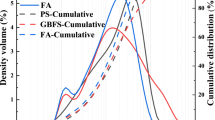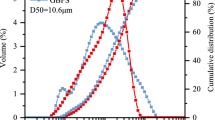Abstract
Spontaneous combustion gangue (SCG) is often used as aggregate in traditional cemented paste backfill (CPB) for mine backfill, but the activation of SCG is insufficient. To stimulate the activity of SCG for the preparation of spontaneous combustion gangue-granulated blast furnace slag backfill (SGB), a new CPB was prepared by activating SCG via a mechanochemical composite activation method and adding ground granulated blast furnace slag (GGBS) to improve its activity. The mixing ratio was optimized by the response surface method and satisfaction function, and the strength formation mechanism was analyzed by scanning electron microscopy–energy dispersive spectrometer (SEM–EDS) and Fourier transform infrared spectroscopy (FTIR). The results showed that SCG had a certain pozzolanic activity, and the optimal grinding time was 30 min. The optimal mix ratio was 82.58% mass concentration, 2.93% alkali content, 30% GGBS content, and 52.92% fine gangue rate. Calcium silicate hydrate (C-S-H) gel and calcium aluminate sulfate hydrate (C-A-S-H) gel were the main reaction products of backfill, and with increasing curing age, C-S-H gel in the reaction system was gradually converted into C-A-S-H gel. FTIR analysis results showed that there were H-O-H, Si-O, and Si-O-T (T was Si or Al) bonds in the product, indicating that C-S-H gel and C-A-S-H gel were formed in the product. A new damage constitutive model was developed. The damage constitutive model could completely describe the backfill stress-strain curve. The study verified the feasibility of preparing cemented paste backfill with SCG and GGBS, which was beneficial to clean coal mine production and environmental protection.













Similar content being viewed by others
References
Achara BE, Mohammed BS, Liew MS (2019) Bond behaviour of nano-silica-modified self-compacting engineered cementitious composite using response surface methodology. Construct Build Mater 224:796–814
Bezerra MA, Santelli RE, Oliveira EP, Villar LS, Escaleira LA (2008) Response surface methodology (RSM) as a tool for optimization in analytical chemistry. Talanta 76(5):965–977
China Aggregates Association GB/T 14684-2022 (2022) Sand for construction. General Administration of Quality Supervision, Inspection and Quarantine of the People's Republic of China, p 28
China Academy of Building Research GB/T 50080-2016 (2016) Standard for test method of performance on ordinary fresh concrete. China Architecture & Building Press
China Building Materials Academy GB/T 12957-2005 (2005) Test method for activity of industrial waste slag used as addition to cement. General Administration of Quality Supervision. Inspection and Quarantine of the People's Republic of China, Standardization Administration of the People's Republic of China, p 8
China Building Materials Academy GB/T 2847-2022 (2022) Pozzolanic materials used for cement production. State Administration for Market Regulation, Standardization Administration of the People's Republic of China p. 16
Cao S, Yilmaz E, Yin Z et al (2021) CT scanning of internal crack mechanism and strength behavior of cement-fiber-tailings matrix composites. Cem Concr Compos 116:103865
Chen Q, Luo K, Wang Y, Li X, Zhang Q, Liu Y (2022) In-situ stabilization/solidification of lead/zinc mine tailings by cemented paste backfill modified with low-carbon bentonite alternative. J Mater Res Technol 17:1200–1210
Chen Q, Zhang Q, Qi C, Fourie A, Xiao C (2018) Recycling phosphogypsum and construction demolition waste for cemented paste backfill and its environmental impact. J Clean Prod 186:418–429
Chen X, Shi X, Zhou J, Du X, Chen Q, Qiu X (2019) Effect of overflow tailings properties on cemented paste backfill. J Environ Manage 235:133–144
Ding Y (2021) Study on the mechanical properties and strength evolution characteristics of aeolian sand filling. Xian University of Science and Technology. https://doi.org/10.27397/d.cnki.gxaku.2021.000035
Fang X, Li J, Li J, Chen S, Yao Z (2018) Damage constitutive model of biocemented coral sand columns under unconfined compression. Chinese J Undergr Space and Engineering 14(05):1234–1239
Garcia-Lodeiro I, Palomo A, Fernández-Jiménez A, Macphee DE (2011) Compatibility studies between N-A-S-H and C-A-S-H gels. Study in the ternary diagram Na2O–CaO–Al2O3–SiO2–H2O. Cem Concr Res 41(9):923–931
He Y, Chen Q, Qi C, Zhang Q, Xiao C (2019) Lithium slag and fly ash-based binder for cemented fine tailings backfill. J Environ Manage 248:109282
Huang G, Ji Y, Li J, Hou Z, Dong Z (2018a) Improving strength of calcinated coal gangue geopolymer mortars via increasing calcium content. Construct Build Mater 166:760–768
Huang S, Liu Q, Cheng A (2018b) A statistical damage constitutive model under freeze-thaw and loading for rock and its engineering application. Cold Reg Sci Technol 145:142–150
Jiang H, Qi Z, Yilmaz E, Han J, Qiu J, Dong C (2019) Effectiveness of alkali-activated slag as alternative binder on workability and early age compressive strength of cemented paste backfills. Construct Build Mater 218:689–700
Kang K, Song Y, Yu X (2022) Study on early mechanical properties and damage constitutive model of tailing-cemented backfill with different fibers. Chinese J Rock Mech and Engineering 41(02):282–291
Lai Y, Zhao K, Yan Y, Yang J, Wu J, Ao W, Guo L (2022) Damage study of fiber-doped superfine tailings cemented backfill based on acoustic emission cumulative ringing count. J Mater Sci 57(25):11612–11629. https://doi.org/10.1007/s10853-022-07280-y
Lemaitre J (1984) How to use damage mechanics. Nucl Eng Des 80(2):233–245
Li H, Sun H, Xiao X (2005) Study on gangue-containing aluminosilicate based cementitious materials. J China Coal Soc 06:778–782
Li M, Zhang J, Li A, Zhou N (2020) Reutilisation of coal gangue and fly ash as underground backfill materials for surface subsidence control. J Clean Prod 254:120113. https://doi.org/10.1016/j.jclepro.2020.120113
Li X, Li K, Sun Q, Liu L, Yang J, Xue H (2021) Preparation of cemented oil shale residue–steel slag–ground granulated blast furnace slag backfill and its environmental impact. Materials 14(8):2052
Liu C, Deng X, Liu J, Hui D (2019) Mechanical properties and microstructures of hypergolic and calcined coal gangue based geopolymer recycled concrete. Construct Build Mater 221:691–708
Liu L, Ruan S, Qi C, Zhang B, Tu B, Yang Q, Song K-I (2021a) Co-disposal of magnesium slag and high-calcium fly ash as cementitious materials in backfill. J Clean Prod 279:123684
Liu W, Chen J, Guo Z (2021b) Mechanical properties and damage evolution of cemented coal gangue-fly ash backfill under uniaxial compression: effects of different curing temperatures. Construct Build Mater 305:124820. https://doi.org/10.1016/j.conbuildmat.2021.124820
Ma H, Zhu H, Yi C, Fan J, Chen H, Xu X, Wang T (2019) Preparation and reaction mechanism characterization of alkali-activated coal gangue–slag materials. Materials 12(14):2250
Nambiar EKK, Ramamurthy K (2006) Models relating mixture composition to the density and strength of foam concrete using response surface methodology. Cem Concr Compos 28(9):752–760. https://doi.org/10.1016/j.cemconcomp.2006.06.001
Qin L, Gao X, Su A, Li Q (2021) Effect of carbonation curing on sulfate resistance of cement-coal gangue paste. J Clean Prod 278:123897. https://doi.org/10.1016/j.jclepro.2020.123897
Shi X, Zhang C, Wang X, Zhang T, Wang Q (2022) Response surface methodology for multi-objective optimization of fly ash-GGBS based geopolymer mortar. Construct Build Mater 315:125644
Song W, Zhu Z, Pu S, Wan Y, Xu X, Song S, Zhang J, Yao K, Hu L (2020) Multi-technical characterization and correlations between properties of standard cured alkali-activated high-calcium FA binders with GGBS as additive. Constr Build Mater 241:117996. https://doi.org/10.1016/j.conbuildmat.2020.117996
Sun Q, Cai C, Zhang S, Tian S, Li B, Xia Y (2019a) Study of localized deformation in geopolymer cemented coal gangue-fly ash backfill based on the digital speckle correlation method. Construct Build Mater 215:321–331
Sun Q, Tian S, Li B, Cai C, Xia Y, Wei X, Mu Q (2019b) Preparation and microstructure of fly ash geopolymer paste backfill material. J Clean Prod 225:376–390
Sun Q, Wei X, Li T, Zhang L (2020) Strengthening behavior of cemented paste backfill using alkali-activated slag binders and bottom ash based on the response surface method. Materials 13(4):855
Wang C, Liu C, Pei W, Li Z (2022) Discussion on the preparation of roadbed filling material with activated coal gangue. J Mater. Sci. Eng 40(01):97–103
Wang K, Jiang Y, Xu C (2018) Mechanical properties and statistical damage model of coal with different moisture contents under uniaxial compression. Chinese J Rock Mech and Engineering 37(05):1070–1079
Wang S, Luo K, Wang X, Sun Y (2016) Estimate of sulfur, arsenic, mercury, fluorine emissions due to spontaneous combustion of coal gangue: an important part of Chinese emission inventories. Environ Pollut 209:107–113
Wang Y, Lu H, Wu J (2021) Experimental investigation on strength and failure characteristics of cemented paste backfill-rock composite under uniaxial compression. Construct Build Mater 304:124629
Weng L, Sagoe-Crentsil K (2007) Dissolution processes, hydrolysis and condensation reactions during geopolymer synthesis: part i—low Si/Al ratio systems. J Mater Sci 42(9):2997–3006
Wu D, Sun W, Liu S (2021) Effect of microwave heating on thermo-mechanical behavior of cemented tailings backfill[J]. Construct Build Mater 266:121180
Xin J, Liu L, Jiang Q, Yang P, Qu H, Xie G (2022) Early-age hydration characteristics of modified coal gasification slag-cement-aeolian sand paste backfill. Constr Build Mater 322:125936. https://doi.org/10.1016/j.conbuildmat.2021.125936
Yue C (2021) Low-carbon binders produced from waste glass and low-purity metakaolin for cemented paste backfill. Constr Build Mater 312:125443. https://doi.org/10.1016/j.conbuildmat.2021.125443
Zhang W, Dong C, Huang P, Sun Q, Li M, Chai J (2020) Experimental study on the characteristics of activated coal gangue and coal gangue-based geopolymer. Energies 13(10). https://doi.org/10.3390/en13102504
Zhao D (2021) Reactive MgO-modified slag -based binders for cemented paste backfill and potential heavy-metal leaching behavior. Construct Build Mater 298:123894. https://doi.org/10.1016/j.conbuildmat.2021.123894
Zhou M, Wang R, Chen C, Zhao H, Qu H (2015) Preparation and effect of coal-gangue admixture on high strength concrete. Non-metallic Mines 38(05):27–30
Acknowledgements
The author would like to acknowledge the valuable suggestions of the editor and two anonymous reviewers.
Additionally, we would like to thank Wang Siyuan from Shiyanjia Lab (http://www.shiyanjia.com)
Availability of data and materials
Not applicable
Funding
The authors thank the National Natural Science Foundation of China (no. 52074144 and 52104132), the Scientific Research Fund of Liaoning Provincial Education Department (no. LJ2020JCL037), and the Discipline Innovation Team of Liaoning Technical University (no. LNTU20TD-12).
Author information
Authors and Affiliations
Contributions
All authors contributed to the study’s conception and design. Material preparation and data collection and analysis were performed by Ruifeng Ma, Gujian Wang, and Qi Sun. The first draft of the manuscript was written by Ruifeng Ma and Gujian Wang. Ruifeng Ma and Gujian Wang contributed to this work equally. All authors commented on previous versions of the manuscript. All authors read and approved the final manuscript.
Corresponding author
Ethics declarations
Ethics approval and consent to participate
Not applicable
Consent for publication
Not applicable
Competing interests
The authors declare no competing interests.
Additional information
Responsible Editor: Philippe Garrigues
Publisher’s note
Springer Nature remains neutral with regard to jurisdictional claims in published maps and institutional affiliations.
Rights and permissions
Springer Nature or its licensor (e.g. a society or other partner) holds exclusive rights to this article under a publishing agreement with the author(s) or other rightsholder(s); author self-archiving of the accepted manuscript version of this article is solely governed by the terms of such publishing agreement and applicable law.
About this article
Cite this article
Ma, R., Wang, G. & Sun, Q. Preparation and strength formation mechanism of alkali-stimulated spontaneous combustion gangue-granulated blast furnace slag backfill. Environ Sci Pollut Res 31, 723–739 (2024). https://doi.org/10.1007/s11356-023-30893-y
Received:
Accepted:
Published:
Issue Date:
DOI: https://doi.org/10.1007/s11356-023-30893-y




